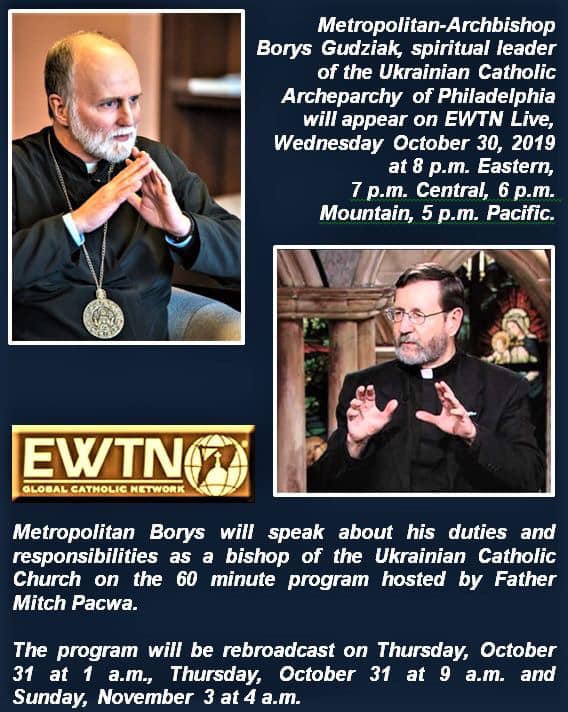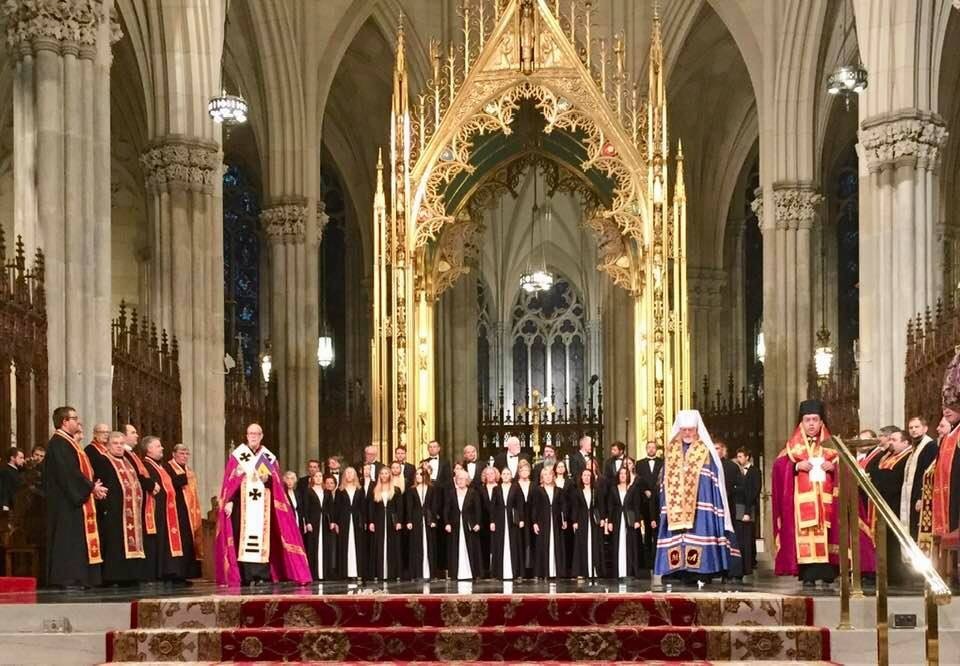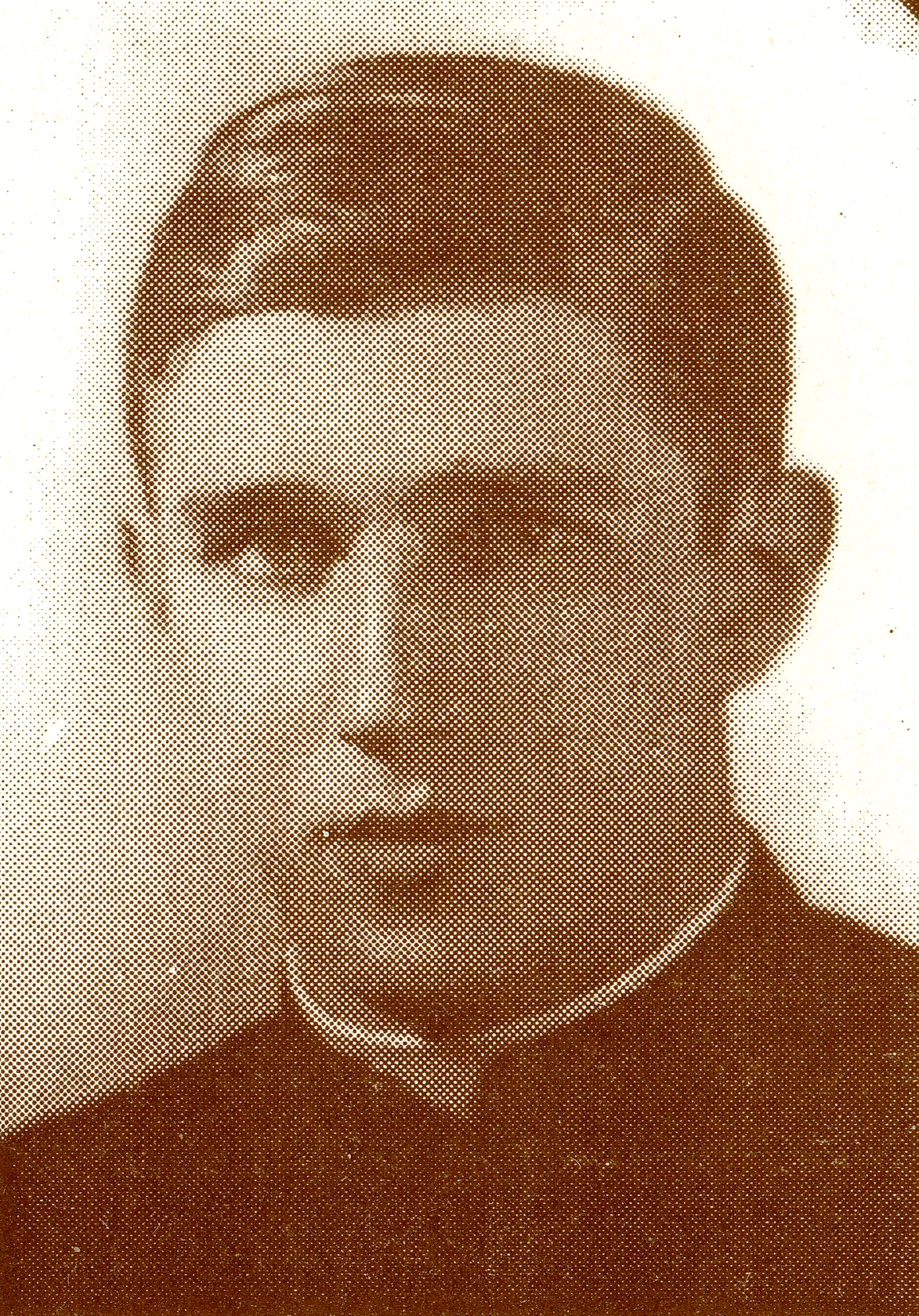
Divine Liturgy for the coming week
Glory to Jesus Christ!
Sunday, 10/20, 19 Sunday after Pentecost —The Holy Great-Martyr Artemius
9:00 a.m. +Father Edward T. Oakes, S.J. requested by Paul A. Zalonski
10:30 a.m. For our parishioners
Epistle: 2 Corinthians 11:31-12:9
Gospel: Luke 16:19–31, Tone 2
Monday, 10/21, Our Venerable Father Hilarion the Great
8:00 a.m. +Dmytro Bodnar (Pan.) requested by Maria Wysowskyj
Tuesday, 10/22, The Holy Wonderworker and Equal-to-the Apostles Abercius
9:00 a.m. No intention for the Divine Liturgy
Wednesday, 10/23, The Holy Apostle and Brother of the Lord in the Flesh James
9:00 a.m. No intention for the Divine Liturgy
Thursday, 10/24, The Holy Martyrs Aretas and companions
9:00 a.m. No intention for the Divine Liturgy
Friday, 10/25, The Holy Martyrs and Notaries Marcian and Martyrius
9:00 a.m. No intention for the Divine Liturgy
Saturday, 10/26, The Holy and Glorious Great-Martyr Demetrius, from Whose Tomb Myrrh Streams Forth
9:00 a.m. No intention for the Divine Liturgy
Sunday, 10/27, 20th Sunday after Pentecost —The Holy Martyr Nestor
9:00 a.m. +Michael Zalonski requested by Paul A. Zalonski
10:30 a.m. For our parishioners
Epistle: Galatians 1:11-19
Gospel: Luke 8:26-39, Tone 3
Parish announcements this week
Christ is in our midst!
This week’s vigil light is offered to God’s glory by Nina Baker and family in memory of Natalie Cybriwsky.
We would like to congratulate Rudolph III and Nicole Brezicki on the occasion of the Holy Baptism and Chrismation of their daughter Tessa Rose, which took place on Saturday, September 21, in our church. Many happy and blessed years!
Pyrohy Project: We change the date for making Pyrohy for November, from November 23rd to November 16th.
Ukrainian American Veterans will hold our National Convention here in New Haven Thursday, October 3st thru Saturday, November 2nd. We expect 140 attendees at the convention and we are asking for your help to make this event a success. Please contact Post Commander Carl Harvey for further details and how you can help. Thank you!
St. Michael’s Day will be celebrated on November 24th. On this day we will have only one (1) Divine Liturgy at 10:30 a.m.. After the Divine Liturgy, we will have a dinner and short program. All parishioners are cordially invited to this celebration. Tickets are available through Miss Luba Dubno. Tickets are $25.00 for adults, $10.00 for youth between 14and 18. Free for students Ridna Shkola, altar boys and for children under 12. We will be running a raffle. If you would like to donate any items to be raffled, please bring them to our church hall on Sundays before our Feast Day. Also we ask for donations for dessert.
The Ukrainian Ridna Shkola of New Haven had started its school year with 3 classes: 1.) A nursery school program for children 3-5 years old; 2.) A class to teach Ukrainian to English language-speaking children ages 6-10; 3.) A class where instruction is only in the Ukrainian language for children 8-11 years old. Classes are from 9:30 to 11:30 each Saturday morning. Religious instruction follows at 11:30 am. We are planning Ukrainian dance instruction as well.
CT Pro-Life Conference, November 2nd, 9am-3pm at Saint Paul High School 1001, Stafford Avenue, Bristol CT. Workshops/Speakers/Advocacy 101. To register $15 lunch included; $5 for students with ID; visit http://www.ctfamily.org
Saying Farewell to Kostya and Iryna
 We invite everyone to a farewell reception for our wounded soldier Kostya Shkapoyed and his wife Iryna. The reception will be in St. Michael’s Church hall 569 George St, New Haven on Sunday, October 27th at 12:00 noon. Kostya’s treatment at Yale has been completed and he and Iryna are returning to Ukraine. Let’s give him a nice send off and wish him and Iryna well as they return home.
We invite everyone to a farewell reception for our wounded soldier Kostya Shkapoyed and his wife Iryna. The reception will be in St. Michael’s Church hall 569 George St, New Haven on Sunday, October 27th at 12:00 noon. Kostya’s treatment at Yale has been completed and he and Iryna are returning to Ukraine. Let’s give him a nice send off and wish him and Iryna well as they return home.
Запрошуємо всіх на пращальну зустріч з нашим пораненим воїном Костянтином Шкапоєдом і його дружиною Ірою. Зустріч відбудеться в неділю 27 -ого жовтня о год. 12:00 у залі при церкві Св. Михайла 569 George St, New Haven. Лікування в Yale закінчилось, Костя і Ірина повертаються до дому. Прошу прийти попрощатися з ними ї побажати їм всього найкращого на майбутнє.
Coffee social
 UNWLA #108 invites all women to a coffee social on Sunday, October 27, 2019 after each Divine Liturgy at St. Michael’s Ukrainian church hall to meet current members and others who may be interested in continuing the vital work of the local, regional, and national Ukrainian women’s organization.
UNWLA #108 invites all women to a coffee social on Sunday, October 27, 2019 after each Divine Liturgy at St. Michael’s Ukrainian church hall to meet current members and others who may be interested in continuing the vital work of the local, regional, and national Ukrainian women’s organization.
Established in 1925, the Ukrainian National Women’s League of America (UNWLA) is the longest-running and largest Ukrainian women’s organization in the US. Our mission: uniting women of Ukrainian descent and affiliation in service, friendship and dedication in order to promote and develop educational and cultural efforts and humanitarian assistance to Ukrainians worldwide.
Союз Українок Америки (СУА ) відділ 108-й запрошує всіх жінок поспілкуватися за кавою, в неділю 27 жовтня 2019, після кожної Служби Божої, в залі, при церкві св.Михаїла в Нью Гейвен і зустрітися з членками організації та іншими жінками, які зацікавлені у продовженні важливої праці, яку веде українська жіноча організація на місцевому, регіональному та державному рівні.
Заснована у 1925 році, Союз Українок Америки, найдовготриваліша і найбільша українська жіноча організація у Сполучених Штатах. Нашим завданням є об’єднання жінок українського походження та приалежності, до служіння, дружби і відданості з метою сприяння та розвитку освіти і культури, а також гуманітарної допомоги українцям по цілому світі.
Holodomor Remembrance 2019
 The 2019 Holodomor Remembrance in New York City will take place on Saturday, November 16
The 2019 Holodomor Remembrance in New York City will take place on Saturday, November 16
The bus trip is on “First Come, First Serve.” Dyakuyu.
May Christ our true God, risen from the dead, place the souls of His departed servants, the victims of the Holodomor genocide, in the abode of the Saints, grant them rest in the bosom of Abraham, and number them among the righteous, through the prayers of His most pure Mother, of the holy, glorious, and praiseworthy Apostles, of our venerable and God‐bearing Fathers, and of all the Saints; may He have mercy on us and save us, for He is good and loves mankind.
Bus Itinerary Pickup
9:00 a.m. Corpus Christi School Parking Lot-581 Silas Deane Hwy, Wethersfield
9:30 a.m. Ikea Parking Lot (rear)-Brewery Street, New Haven
10:00 a.m. Senior Center Parking Lot, Exit 32, Stratford
12:00 noon Drop- off at St. Patrick Cathedral, Fifth Avenue
2:00 p.m. Holodomor Memorial Service at St. Patrick Cathedral
4:00 p.m. Pickup to return to Stratford/New Haven/Hartford
Cost
Adults: $40.00 per person
Students: $20.00 per person
To reserve seats today, please contact:
Myron Kolinsky: 860-563-4072
Ihor and Natalia Rudko: 860-537-4051
Ivan Kebalo: 860-299-6727
Halia Lodynsky: 203-494-6278
Christina Kowinko: 203-380-2892
CT Pro-Life Conference 2019
CT Pro-Life Conference, November 2nd, 9am-3pm at St. Paul High School, 1001 Stafford Avenue, Bristol, CT. Workshops/Speakers/Advocacy 101.
To register: $15 lunch included; $5 students with ID —visit www.ctfamily.org
The Senator’s October ’19 visit to St Michael’s
 On Sunday, October 13th Senator Richard Blumenthal addressed the Ukrainian American community at St Michael’s Church hall in New Haven . His presentation focused on current efforts in Congress to support Ukraine. For the upcoming fiscal year $250 million is being authorized for defense -related assistance. Another $140 million is being allocated for non defense aid through USAID programs in the State Department. While he touched briefly on the House impeachment investigation he was clear that this political activity had no bearing on the ongoing support for Ukraine on Capitol Hill. In Congress Ukraine continues to enjoy strong bipartisan support.
On Sunday, October 13th Senator Richard Blumenthal addressed the Ukrainian American community at St Michael’s Church hall in New Haven . His presentation focused on current efforts in Congress to support Ukraine. For the upcoming fiscal year $250 million is being authorized for defense -related assistance. Another $140 million is being allocated for non defense aid through USAID programs in the State Department. While he touched briefly on the House impeachment investigation he was clear that this political activity had no bearing on the ongoing support for Ukraine on Capitol Hill. In Congress Ukraine continues to enjoy strong bipartisan support.
Prior to the presentation our Veterans organization met with the Senator for an update on the Wounded Ukrainian Soldiers (WUS) program .
Media coverage of the event was exceptional with channel 8 WTNH (ABC) , channel 3 WFSB ( CBS) and FOX 61 camera crews present . In addition both the New HAVEN Register and the Hartford Courant covered the event.
Yevshan Ukrainian Vocal Ensemble celebrates 20th year with a Concert

Blessed Roman Lysko
 Today, on the liturgical calendar the UGCC Church liturgically remembers Blessed Roman Lysko who died on this date following torture and starvation in 1949. He was born on 14 August 1914 in the Horodok, Lviv District, Ukraine.
Today, on the liturgical calendar the UGCC Church liturgically remembers Blessed Roman Lysko who died on this date following torture and starvation in 1949. He was born on 14 August 1914 in the Horodok, Lviv District, Ukraine.
Father Roman was a married priest and pastor. He was ordained priest by Metropolitan Sheptytsky. The NKVD called Father Roman cray for signing the Psalms aloud in prison.
Pope St. John Paul II recognized that Father Roman died as a martyr, and beatified him on 27 June 2001.
Blessed Roman Lysko, pray for us.